
|   |

|   |
Nayika: A profound homage to women - Satish Suri e-mail: satishism@yahoo.co.in Photos: Prof. K.S. Krishnamurthy April 4, 2025 'Nayika' curated by Vyjayanthi Kashi of the Shambhavi School of Dance, was a profound homage to the women who have shaped and elevated the art of Indian classical dance. This production, presented on March 15th at Seva Sadan, Bangalore, celebrated their unwavering dedication, artistic brilliance, and invaluable contributions to preserving and enriching this cultural heritage. Through 'Nayika,' Vyjayanthi Kashi honoured their creative legacy and highlighted their resilience and passion in nurturing the timeless art forms. Yagyaseni 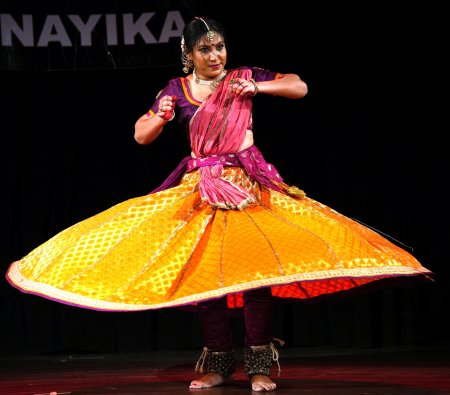 Sangita Chatterjee The Kathak dance theatre presentation by Sangita Chatterjee was nothing short of a masterpiece - a profound and soul-stirring journey into the life of Draupadi, one of the most enigmatic and powerful figures from the Mahabharata. Through the fluidity of Kathak, the performance was a luminous tribute to Draupadi's enduring legacy. It celebrated her as a woman of unparalleled strength, resilience, and faith while also revealing her vulnerabilities and humanity. Through Sangita Chatterjee's artistry, the audience witnessed Draupadi's journey not merely as a tale from an ancient epic but as a timeless narrative of courage, devotion, and the relentless pursuit of justice. The opening sequence, where Draupadi questions the bloodshed and reflects on the identities of those entangled in the chaos, sets a tone of introspection and raw emotion. This moment of vulnerability immediately drew the audience into her world, framing her not just as a queen or a wife but as a woman grappling with the weight of destiny, duty, and injustice. The portrayal of her sacred bond with Krishna, whom she fondly calls her Saka-her eternal guide, protector, and confidant-added a divine dimension to the narrative, illuminating her reliance on him as her anchor through every storm. The performance unfolded like a tapestry, weaving together the defining moments of Draupadi's life: her mystical birth from the sacrificial fire, her swayamvara where Arjuna wins her hand, her anguish as the wife of five husbands, the catastrophic game of dice, her exile, and her poignant reflections on motherhood and her sons. Each scene was rendered with exquisite detail, blending intricate choreography with profound emotional depth. A particularly tender moment was her interaction with her pet bird, where she playfully vows to cast a spell and tweak its beak-a fleeting glimpse of her softer, more human side amidst the grandeur of her struggles. Her declaration that she does not seek moksha but wishes to return as Krishna's instrument to fight injustice against women added a stirring layer of defiance and purpose, making her a timeless symbol of resilience and empowerment. Sangita Chatterjee's artistry shone brilliantly in her execution of nritta. The rapid tempo changes, the precision of her percussive footwork, and the breathtaking whirl of her chakkars were a testament to her technical mastery. Yet, it was her abhinaya that truly captivated her rendition; her subtle facial expressions, graceful hand gestures (mudras), and evocative body language conveyed the full spectrum of Draupadi's emotions, from fiery rage to quiet sorrow. The integration of dialogues and rhythmic patterns further enriched the narrative, creating a seamless blend of movement and meaning. The musical accompaniment, with its soul-stirring melodies and hauntingly beautiful compositions, provided a rich auditory landscape that deepened the emotional impact of the performance. The lyrics by Himanshu Srivastava added a poetic resonance, perfectly complementing the dance and enhancing the storytelling. Draupadi's poignant declaration to Krishna-"If you are the fire of Yagya, I am the Yagyaseni"-epitomized her indomitable spirit and unyielding resolve, leaving an indelible mark on the audience. Kanyakumari 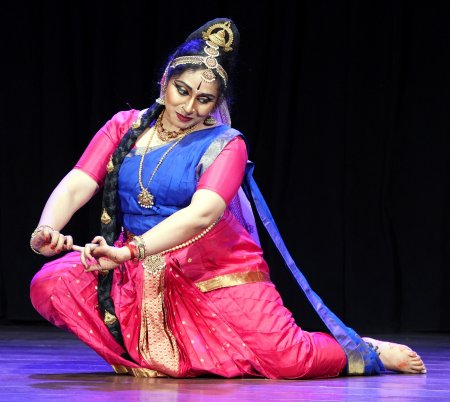  The Shambhavi School of Dance ensemble presented excerpts from their unique production 'Kanyakumari.' The Kuchipudi performance featuring dancers Ashwini C.H., Shivani Avadhani, Aneja, C.R., Sayuja Mazumdar, and Prateeksha Kashi portrayed the poignant and powerful tale of Goddess Kanyakumari with remarkable artistry and emotional depth. The story, rooted in mythology, revolves around the goddess's dual destiny-her divine mission to slay the demon Banasura and her eternal longing for Lord Shiva, whom she was destined to marry. The dancers masterfully encapsulated the narrative through their vibrant movements, nuanced expressions, and seamless synchronization, aligning perfectly with the storyline conceptualized by D.N. Murthy. The choreography by Vyjayanthi Kashi was a testament to her creative vision, blending traditional Kuchipudi techniques with dramatic storytelling to convey the goddess's strength, devotion, and heartbreak. The music composed by Chandana Bala added a soulful dimension to the performance, enhancing the emotional and spiritual undertones of the story. The rhythmic patterns and melodic arrangements complemented the dancers' movements, creating a harmonious blend of sound and motion that transported the audience into the mythological world of Kanyakumari. Key moments of the performance, such as the intervention of Sage Narada, the divine revelation of Kanyakumari's cosmic duty, and the epic battle with Banasura, were conveyed with striking intensity and grace. The dancers' portrayal of Kanyakumari's eternal wait for Shiva, tinged with longing and devotion, left a lasting impression, highlighting the timeless themes of duty, sacrifice, and unfulfilled love. Mahakali The Kuchipudi presentation by Prof. Anuradha Jonnalagadda and her group served as a fitting and grand finale to the evening. Known for her exceptional skill and dedication to Kuchipudi, Prof. Jonnalagadda, along with her talented ensemble, delivered a performance that was both technically brilliant and emotionally resonant. 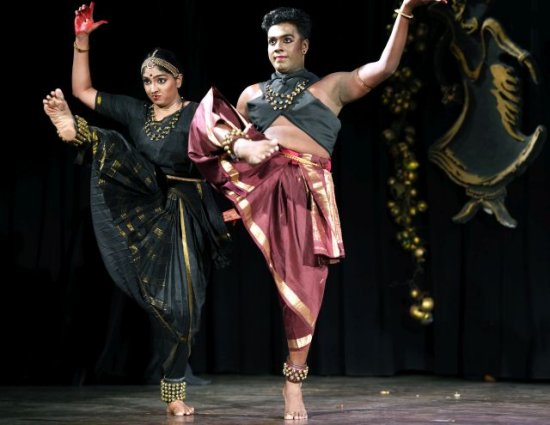 The production was an exploration of mythology, music, dance and philosophy, weaving together the eternal concept of Kaala (time) with the divine intervention of Mahakali to restore cosmic balance. The narrative unfolded seamlessly through five distinct scenes, each contributing to the overarching theme of creation, disruption, protection, dissolution, and renewal to create a captivating experience. It began with a meditation on Kaala, its infinite expanse, and its relentless march. The lyrics, "Ahameva Kaala: Ahameva Kalagati" (I am Time, I am also its pace), resonated like a cosmic mantra, framing Time as both the creator and the force that governs all existence. This set the stage for Mahakali's role as the eternal reality beyond time and space. The homage to the Navagrahas and the depiction of life evolving from simplicity to complexity mirror the cyclical nature of creation, while the emergence of the asuras Shumbha and Nishumbha signals the inevitable rise of chaos, a necessary counterpoint to the divine order. In the second scene, Shumbha and Nishumbha were expressed with ferocious energy by Voggu Praveen and Sreenaiah Bakki, embodying the chaos that disrupts the cosmic balance. Their dominion over the universe, alongside fearsome allies like Chanda, Munda, and Raktabeeja, painted a vivid picture of tyranny. Their performances were electrifying, filled with raw energy and menacing expressions that perfectly captured the chaos and tyranny of the demonic forces. The twirls of their moustaches, their commanding stage presence, and their dynamic choreography made them formidable antagonists, setting the stage for Mahakali's divine intervention. The playful rhythmic interlude added a layer of irony, as their greed and ambition were juxtaposed with their inevitable downfall. This scene captured the timeless struggle between order and chaos, a theme that echoed humanity's eternal plea for salvation in the face of overwhelming darkness. The arrival of the Saptamatrikas (seven mother goddesses) in the third scene heralded the turning of the tide. Each goddess, mounted on her vaahana (vehicle), embodied a unique aspect of divine power. Anuradha Jonnalagadda's narration provided a spiritual anchor, while dancers Gautam and Vaishnavi infused their portrayals with a blend of classical precision and contemporary innovation, bringing a fresh perspective to the traditional forms. Each goddess was distinct, yet together they embodied the collective power and celebration of the Divine Feminine. The jathis inspired by the cries of the vaahanas, added a layer of creativity, blending tradition with innovation. The fourth scene, the climax, was a whirlwind of drama and symbolism. The asuras, despite their might, were repeatedly vanquished by Mahakali, only to rise again. This cycle mirrored the eternal nature of Time and the inevitability of dissolution. The image of Mahakali devouring the earth with her tongue was a haunting metaphor for the ultimate dissolution of all existence into the divine. The battlefield becomes a microcosm of the universe, where creation and destruction dance in tandem. Mahakali's act of consuming everything-the Good, the Bad, the Ugly-signified the end of duality and the return to the primordial source. 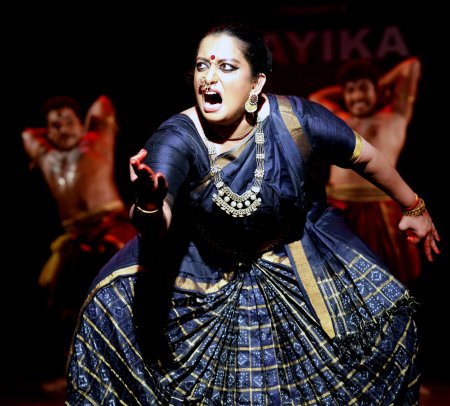 The final scene brought the narrative full circle. Anuradha Jonnalagadda, as the sutradhara (narrator), reminded us of the cyclical nature of existence. The pause in the eternal time cycle is a moment of reflection, a brief stillness before the wheel of creation begins to turn once more. Katyayani Kanak's portrayal of Mahakali was the soul of the production. Her fierce yet compassionate presence, culminating in a sated look tinged with madness, captured the essence of the Goddess as both destroyer and nurturer. Her performance embodied the truth that destruction is not an end but a gateway to renewal. Conceptualized and choreographed by Prof. Anuradha Jonnalagadda Tadakamalla, the production was illustrated by a stellar ensemble of artistes, each contributing their unique artistry to the narrative. Anuradha, serving as the Sutradhara alongside Aparna Dhulipala, anchored the performance with their commanding presence. Together, they guided the audience through the cosmic journey, seamlessly weaving the themes of creation, disruption, and dissolution. At the heart of the production was Dr. Katyayani Kanak, who embodied the titular role of Mahakali with unparalleled grace and intensity. Her portrayal captured the Goddess's dual nature-fierce yet compassionate, destructive yet nurturing. With her compelling stage presence and expressive eyes, she brought Mahakali to life, culminating in a hauntingly powerful depiction of the Goddess in her final, sated form. Vaishnavi Prativadi and Goutham Maheswar portrayed the Saptamatrikas, skillfully depicting each goddess alongside her respective vahana. Each goddess was distinct, yet together they embodied the collective power of the Divine Feminine, showcasing their roles as protectors of the cosmos. The lyrics, music composition, and orchestration by D.S.V. Sastry elevated the production to poetic splendour, infusing it with depth and dynamism. His Telugu verses, rich in imagery, captured the essence of the divine and the demonic with equal brilliance. The music blended traditional Carnatic and Kuchipudi elements with contemporary orchestration, creating a timeless yet innovative soundscape. War instruments during the climactic battle heightened tension, making Mahakali's divine intervention palpable. The jathis were a standout, each inspired by the cries or movements of the Saptamatrikas' vahanas and they enhanced the choreography and visual storytelling. D.S.V. Sastry's work provided the production's backbone, leaving the audience spellbound by its poetic and artistic brilliance. In essence, his lyrical and musical genius elevated the production, making it a memorable celebration of Mahakali's eternal dance and the timeless themes it embodies. 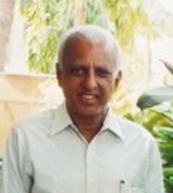 Bangalore based Satish Suri is an avid dance rasika besides being a life member of the Music and Arts Society. |